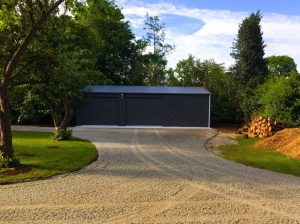Need a strong and sturdy shed that you can also take down in the future if you need to? Do you not have the funds to buy one from the store? Consider building a trampoline shed yourself.
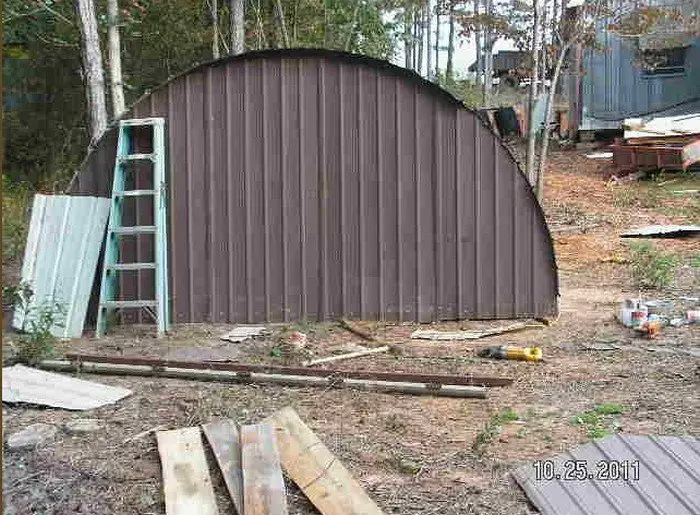
An old trampoline considered unsafe for playing or exercising can still serve several other great purposes! These include great chicken coops, garden trellising, and, as shown here, a frame to build a shed if you need one. It could be a garden shed or easy storage for your tools or lumber.
If you can get enough trampoline frames (and hundreds are dumped every day!), you can even build a larger shelter for your yard equipment like a tractor or riding lawn mower. Perhaps you need a shed for your motorcycle?
You can put the frames together by welding for a really strong structure but bolting definitely works, too.
If you want to know more about how our featured shed was built, you can find the link to Homegrown Engineer’s article below.
Contents
Building a Trampoline Shed
Materials
- Trampoline Frame
- Trampoline Springs/Elastic Tension Bands
- Nuts and Bolts
- Rebar Stakes
- Wire
- 12 mil Tarpaulin
Tools
- Welding Machine
- Cordless Power Drill
Instructions
Step 1: Preparing the Site
- Choose a location for your trampoline shed that is level and clear of any debris or obstacles.
- Lay out the trampoline frame on the ground in the chosen location to mark the perimeter of the shed.
Step 2: Assembling the Frame
- If your trampoline frame is disassembled, connect the pieces using nuts and bolts. Tighten them securely with your cordless power drill.
- For added stability, weld the joints of the frame together using the welding machine. This step is optional but recommended for a more durable structure.
Step 3: Securing the Frame
- Drive rebar stakes into the ground at each corner of the frame, and at several points along the perimeter, using the hammer. These stakes should be at least 2 feet long for proper anchoring.
- Secure the frame to the stakes with wire, wrapping it tightly to prevent any movement. This will help anchor the shed against wind and weather.
Step 4: Attaching the Tarpaulin
- Spread the 12 mil tarpaulin over the frame, ensuring it covers the structure completely. The tarpaulin will act as the roof and walls of your shed.
- Cut the tarpaulin to fit, if necessary, leaving enough overlap for securing it to the frame.
- Attach the tarpaulin to the frame using trampoline springs or elastic tension bands. Hook the springs or bands to the tarpaulin’s eyelets, then connect them to the frame. This method allows for easy removal and provides flexibility in windy conditions.
Step 5: Reinforcing the Structure
- Inspect the shed for any loose areas in the tarpaulin that may need additional springs or bands for tension.
- Use extra wire to reinforce the connection points between the tarpaulin and the frame, especially at the corners and along the edges.
Step 6: Final Touches
- Check the stability of the shed by gently pushing against it from different directions. Add more rebar stakes or wire if needed.
- Consider adding internal features like shelves or hooks for storage, attaching them directly to the frame.
Design Considerations for Trampoline Sheds
Trampoline sheds represent an innovative recycling idea, transforming defunct trampoline frames into practical outdoor sheds. Ideal for storage, workshops, or even as a quaint backyard retreat, these structures are both eco-friendly and versatile.
Designing a trampoline shed requires careful consideration of several factors to maximize its utility and integrate it seamlessly into your outdoor environment.
Structural Integrity
- Frame Condition: Ensure the trampoline frame is in good condition, free of rust and structural damage. This is crucial for the safety and longevity of the shed.
- Reinforcement: Consider reinforcing the frame with additional supports or welding to enhance its strength, especially if the shed will bear significant weight.
- Foundation and Anchoring: Beyond securing the frame with rebar stakes, consider laying a concrete foundation for your shed, especially if it will store heavy items or face extreme weather conditions. A solid foundation improves stability and longevity.
- Reinforcement of Frame Joints: While welding joints can significantly enhance the structure’s durability, using high-grade metal brackets and corrosion-resistant screws or bolts for connections can offer additional support and flexibility for assembly and disassembly.
- Load Distribution: Evaluate the load distribution across the trampoline frame, especially if you plan to hang items or install shelving inside the shed. Strategic placement of support beams or cross-bracing can prevent sagging and ensure the frame bears weight evenly.
Size and Space
- Footprint: Assess the available space in your yard and the size of the trampoline frame to determine the shed’s footprint. This will help in planning the layout and the amount of storage space available.
- Height Considerations: Depending on the trampoline’s original size, the shed’s height may vary. Ensure it is tall enough for comfortable access and use.
- Modular Design: Consider designing your shed with modularity in mind. By creating sections that can be easily added or removed, you can adjust the size of your shed according to your changing needs.
- Interior Layout Optimization: Make the most of the vertical space by installing high shelves or loft storage. This approach maximizes storage capacity without compromising floor space, ideal for smaller sheds.
- Accessibility and Ergonomics: Design doorways and internal configurations with ergonomics in mind. Ensure that entry points are wide enough to accommodate larger items and that the layout allows for easy movement within the shed.
Weatherproofing
- Tarpaulin Quality: Select a high-quality, durable tarpaulin that can withstand weather elements. A 12 mil tarpaulin is recommended for its thickness and durability.
- Sealing Edges: Properly seal the edges of the tarpaulin to prevent water ingress. This might involve additional materials or techniques to ensure a tight fit.
- Enhanced Tarpaulin Fixation: To improve upon basic tarpaulin coverage, implement a dual-layer tarp system with an air gap for insulation and moisture control. This setup can protect against condensation inside the shed.
- Sealing Gaps and Openings: Apply weather stripping or silicone sealant around door frames and any other areas where the tarpaulin meets the frame to prevent water ingress during rainstorms.
- Ventilation: Incorporate ventilation points at strategic locations to prevent the buildup of heat and moisture within the shed. Vents or louvres can be added to the design without compromising weather resistance, promoting air circulation and reducing the risk of mold and mildew.
Accessibility
- Door Design: Create an accessible entrance by cutting a door in the tarpaulin or designing a removable panel. Consider the door’s location for ease of access and its security.
- Ventilation: Ensure the shed has adequate ventilation to prevent condensation and maintain air quality, especially if storing garden chemicals or fuel.
- Entry and Exit Points: For trampoline sheds intended for frequent access, incorporating multiple entry points can improve accessibility. Designing doors on different sides of the shed allows for easier movement and access to stored items from various angles.
- Ramp Installation: Adding a ramp to the main entrance of the trampoline shed can facilitate the movement of wheeled equipment, such as lawn mowers or wheelbarrows, making it more user-friendly for all ages and abilities.
- Lighting: Consider integrating solar-powered lights both inside and outside the trampoline shed. Adequate lighting enhances safety and accessibility during evening hours or in shaded garden areas.
Customization and Aesthetics
- Exterior Design: Customize the shed’s exterior with paint, decorations, or even climbing plants to enhance its appearance and blend with the garden.
- Interior Organization: Plan the interior layout with shelving, hooks, or storage bins to keep items organized and accessible.
- Exterior Finishes: The trampoline shed offers a unique canvas for customization. Beyond tarpaulin covers, consider using exterior-grade paint, murals, or even vertical gardens to create a visually appealing structure that complements your outdoor space.
- Roofing Options: For a more refined look, explore alternative roofing materials such as corrugated metal or polycarbonate panels. These materials can offer better durability and aesthetics than traditional tarpaulin, transforming the trampoline shed into a standout feature.
- Decorative Elements: Incorporate decorative elements like string lights, planters, or custom signage to personalize the trampoline shed. These touches not only enhance the shed’s appearance but also reflect the owner’s style and creativity.
Environmental Considerations
- Sustainability: Emphasize the use of recycled or eco-friendly materials beyond the trampoline frame to minimize environmental impact.
- Integration with Landscape: Design the shed to complement your garden’s landscape, considering its placement relative to trees, paths, and other garden features.
- Sustainable Materials: In addition to repurposing the trampoline frame, consider using recycled or sustainable materials for any additional construction or decoration. For instance, reclaimed wood can be used for shelving or as an alternative to the tarpaulin for parts of the walls.
- Rainwater Harvesting: Equip the trampoline shed with a gutter system to collect rainwater from the roof. This water can be stored in barrels and used for irrigating the garden, reducing water usage and the environmental impact.
- Eco-friendly Insulation: For trampoline sheds used in colder climates, insulation is key to protecting stored items. Use eco-friendly insulation materials, such as sheep’s wool or recycled denim, to line the interior walls without compromising the shed’s green credentials.
A trampoline shed is not just a storage solution; it’s a testament to innovative recycling and creative design. By carefully considering these design elements, you can create a functional, durable, and aesthetically pleasing trampoline shed that serves your needs while contributing positively to the environment.
You can also get similar ideas for an old trampoline frame by viewing our album below! :)
Click on any image to start the lightbox display. Use your Esc key to close the lightbox.![]()
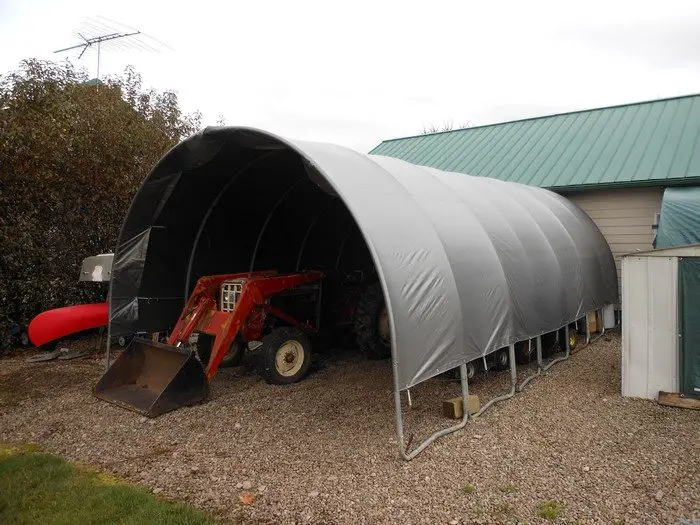
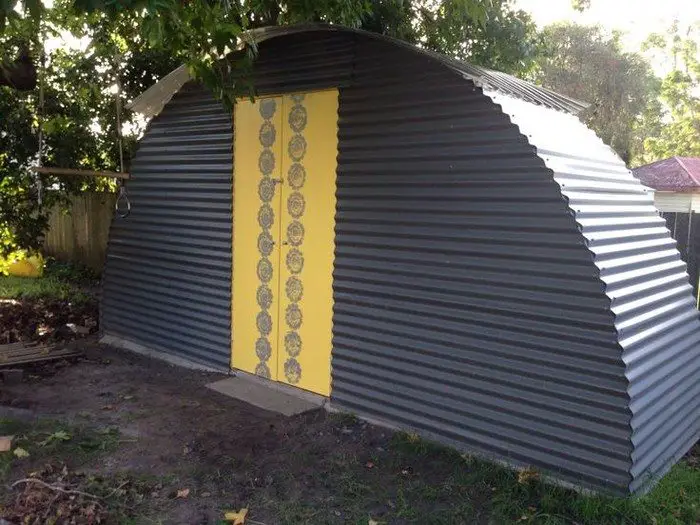

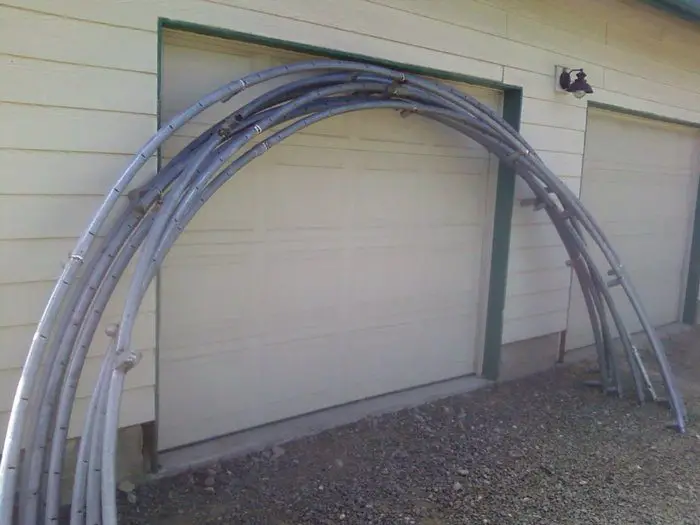



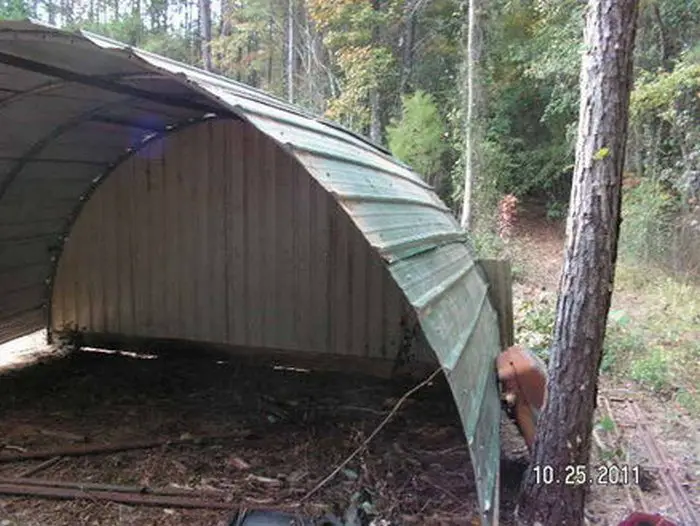
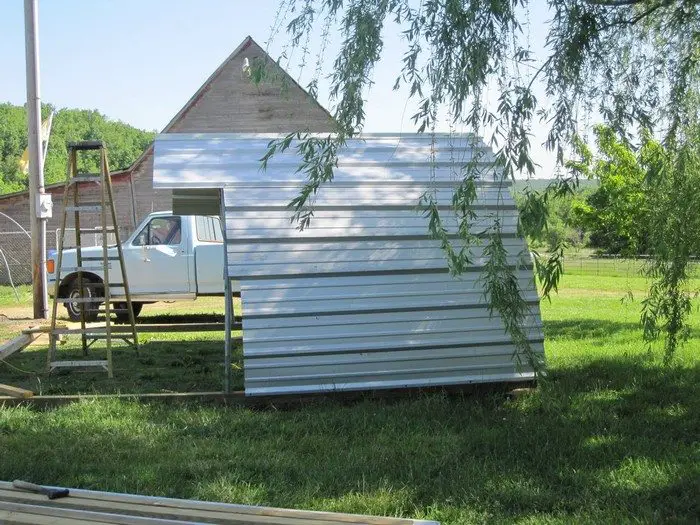
Safety Measures and Maintenance Tips
Maintaining the safety and durability of a trampoline shed involves a combination of vigilant safety measures and consistent maintenance practices. These steps are crucial for ensuring that the shed remains a secure and reliable structure in your outdoor space. By regularly inspecting and caring for the trampoline shed, you can prevent accidents and extend its lifespan, making it a valuable addition to your property for many years.
Comprehensive Assembly Checks
Secure Assembly
When constructing a trampoline shed, it’s crucial to ensure that every component is fitted correctly and securely. This process involves:
- Verifying Component Fit: Before assembly, verify that all parts fit together as intended. Misalignment can lead to stress on the structure and potential failure.
- Sequential Assembly: Follow the assembly instructions in the correct order to avoid having to backtrack or redo steps, which could weaken connections.
- Cross-Checking Stability: Once assembled, physically check the stability of the trampoline shed by gently applying pressure to various parts. This can help identify any weak spots that need additional securing.
Tighten Fasteners
The integrity of the trampoline shed relies heavily on the tightness of its fasteners. To maintain this:
- Scheduled Checks: Establish a routine (e.g., monthly or quarterly) to inspect and tighten nuts, bolts, and springs. This is particularly important after the initial settling period post-assembly.
- Use of Locking Mechanisms: Consider the use of lock nuts, washers, or thread-locking fluid to prevent fasteners from loosening under vibration or movement.
- Replacement of Faulty Fasteners: If any bolts or nuts show signs of corrosion or damage, replace them immediately to prevent failure.
Regular Safety Inspections
Inspect for Damage
Regular inspections are key to identifying and mitigating potential hazards:
- Structural Examination: Conduct thorough examinations of the frame, focusing on areas under high stress or prone to accumulation of moisture, which could lead to rust or corrosion.
- Spring and Tarpaulin Check: Springs should retain their tension and be free from rust, while the tarpaulin should be inspected for rips, tears, or UV damage that could compromise its effectiveness as a cover.
Weather Damage Assessment
The trampoline shed is exposed to the elements, making it susceptible to weather-related damage:
- Post-Storm Inspections: After any significant weather event, perform a detailed inspection to look for any new signs of wear or damage. This includes checking for any water pooling on or around the shed, which could indicate drainage issues.
- Wind Damage: High winds can loosen fasteners or tear tarpaulin. Inspect the shed for any signs of such damage, ensuring the structure remains anchored securely.
- Snow and Ice Accumulation: Heavy snowfall can overload the shed’s structure. Regularly remove snow from the roof and inspect for any bending or deformation of the frame.
Routine Cleaning
Clean the Tarpaulin
Regular cleaning of the tarpaulin is essential for preserving its condition and ensuring it continues to provide adequate protection. To effectively clean the tarpaulin:
- Frequency: Aim to clean the tarpaulin at least twice a year, with additional cleanings after extreme weather events.
- Cleaning Solution: Use a mixture of mild soap and lukewarm water to avoid damaging the material. Harsh chemicals should be avoided as they can degrade the tarpaulin fabric.
- Drying: After washing, ensure the tarpaulin is thoroughly dried in the sun to prevent mold and mildew growth. Never store or fold the tarpaulin when it’s damp.
Frame Maintenance
The frame is the backbone of the trampoline shed and requires regular maintenance to prevent rust and ensure stability:
- Inspection: Examine the frame for signs of rust or corrosion, especially in joints and welds, as these areas are more prone to moisture accumulation.
- Cleaning: Use a wire brush to remove any surface rust before applying a rust-resistant coating. This not only stops the spread of rust but also restores the appearance of the frame.
- Protective Coating: Apply a rust-inhibiting primer followed by a topcoat designed for metal surfaces. These coatings provide a barrier against moisture and oxygen, significantly extending the frame’s lifespan.
Seasonal Adjustments
Prepare for Winter
Preparing the trampoline shed for winter is crucial in regions prone to snow and freezing temperatures:
- Structural Support: Evaluate the need for additional supports to bear the weight of snow on the roof. Temporary bracing or reinforcement can be installed before the winter season.
- Snow Removal: Regularly remove snow from the roof to prevent excessive weight accumulation. Use a soft broom or brush to avoid damaging the tarpaulin or structure.
Ensure Proper Ventilation
Adequate ventilation is key to preventing dampness and condensation within the shed:
- Vent Placement: Install vents at strategic points, such as the highest and lowest parts of the shed, to encourage natural airflow.
- Moisture Control: In addition to vents, consider using moisture-absorbing materials or desiccants inside the shed during the wet season to help control humidity levels.
Component Care and Replacement
Regular Component Checks
Components like springs, nuts, and bolts are critical for the shed’s stability and should be regularly inspected for signs of wear:
- Inspection Schedule: Conduct thorough inspections at the start and end of each season, or more frequently if the shed is exposed to harsh conditions.
- Immediate Replacement: Replace any worn or damaged components immediately to maintain the structural integrity of the shed. Keeping a supply of spare parts on hand can facilitate quick repairs.
Upgrades and Improvements
Enhancing the trampoline shed with upgrades can improve its functionality and resistance to weather:
- Material Upgrades: Invest in higher-quality tarpaulin or waterproof covers designed for outdoor use. These materials offer better UV protection and are more durable against the elements.
- Structural Enhancements: Consider adding additional beams or cross-bracing to strengthen the frame, especially if the shed will be used to store heavy items or if it’s located in an area with high wind or snow loads.
Conclusion
Constructing a trampoline shed offers an innovative and sustainable approach to outdoor storage, and repurposing materials for a new use. This eco-friendly solution not only reduces waste but also provides a versatile and durable space for garden tools, equipment, or leisure areas. The project encourages creativity and practical skills, resulting in a functional and aesthetically pleasing addition to any outdoor space.
For more creative storage solutions at home, check out our garden tool shed project!


